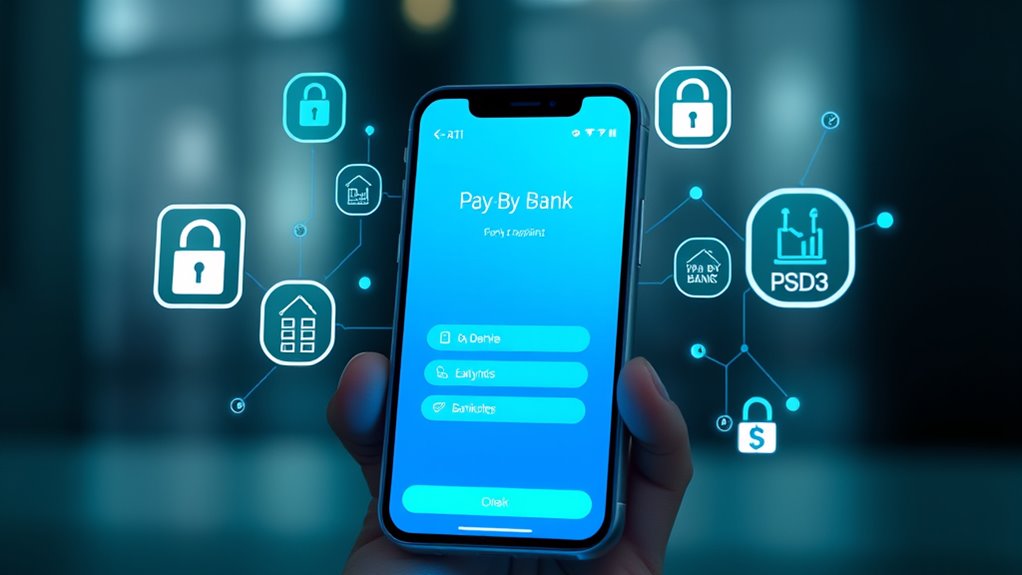PSD3 is set to strengthen pay-by-bank and open banking payments by boosting security, transparency, and consumer rights. It requires banks and fintechs to meet stricter standards like multi-factor authentication and data protection, reducing fraud risks. You’ll benefit from clearer dispute processes and better control over your finances. With these updates, trust in digital payments grows even more. Keep going to discover how these changes confirm your online transactions are safer and more transparent than ever.
Key Takeaways
- PSD3 enhances transparency, security, and consumer rights for pay-by-bank and open banking payments.
- It mandates stricter security standards like multi-factor authentication and encryption.
- PSD3 promotes greater accountability and dispute resolution processes for digital transactions.
- The regulation encourages safer, more resilient open banking platforms with fraud detection tools.
- Overall, PSD3 boosts consumer confidence and trust in digital, bank-led payment methods.

Open Banking payments and pay-by-bank methods are transforming how you make transactions online. These innovative approaches put you in control, offering a smoother and more direct way to pay, while also emphasizing the importance of consumer protection and security standards. As these payment methods become more prevalent, they’re reshaping the landscape by prioritizing transparency and safety, giving you confidence when sharing your banking details online.
With pay-by-bank options, you avoid the need for traditional card-based payments, which often involve sharing sensitive card information with multiple merchants. Instead, you authenticate directly through your bank, reducing the risk of data breaches and fraud. This shift enhances consumer protection because your bank’s security measures guard your funds and personal information more effectively. It also means fewer opportunities for cybercriminals to intercept your payment details, making transactions safer overall.
Security standards are at the core of these new payment methods. Banks and fintech providers are required to meet strict regulations designed to safeguard your data and ensure secure transactions. These standards include multi-factor authentication, encryption, and real-time monitoring to detect suspicious activity. As a user, you benefit from these robust security protocols because they minimize vulnerabilities and reinforce your trust in the system. This focus on security standards is especially important as digital payments become more complex and widespread.
Furthermore, open banking platforms often incorporate advanced fraud detection tools, which analyze transaction patterns and flag anomalies instantly. This proactive approach helps prevent unauthorized transactions and protects your account from potential threats. You’re less vulnerable to common online payment risks because these systems are built to be resilient and transparent, providing clear information about each step of the payment process.
Consumer protection is also strengthened through regulations like PSD3, which aims to enhance transparency and accountability in open banking payments. These regulations make it easier for you to understand your rights, dispute unauthorized charges, and ensure that your bank is responsible for safeguarding your funds. As these rules evolve, they reinforce your confidence in using pay-by-bank methods, knowing that there are legal frameworks supporting your safety and rights. Additionally, the use of comprehensive security standards ensures that all parties involved adhere to best practices, further boosting consumer trust.
Frequently Asked Questions
How Will PSD3 Change Customer Authentication Processes?
You’ll notice PSD3 streamlines customer verification by making authentication workflows more seamless and secure. It emphasizes stronger, multi-factor authentication methods, reducing friction during transactions. As a result, you’ll experience faster, more reliable authentication processes that prioritize your security without complicating your payments. This shift aims to enhance trust and confidence in digital payments, ensuring your verification methods are both robust and user-friendly while meeting evolving regulatory standards.
What New Security Measures Will PSD3 Introduce?
PSD3 will introduce new security measures that reinforce transaction security and fraud prevention. You’ll see enhanced authentication protocols, requiring multi-factor verification to confirm identity. These measures aim to reduce fraud risks and ensure safer payments. You’ll benefit from improved monitoring systems that detect suspicious activities more effectively. Overall, PSD3’s security updates help protect your financial data, making transactions more secure and trustworthy while reducing the chance of unauthorized access.
Will PSD3 Impact International Open Banking Collaborations?
Yes, PSD3 will impact international open banking collaborations by promoting cross-border standards and regulatory harmonization. You’ll find it easier to work across different jurisdictions because PSD3 aims to create unified frameworks, reducing barriers and inconsistencies. This encourages collaboration, streamlines processes, and enhances security measures globally. As a result, your international open banking initiatives will benefit from clearer rules and more seamless integration, boosting confidence and efficiency in cross-border payments.
How Will PSD3 Affect Small and Medium-Sized Enterprises?
PSD3 is a game-changer for SMEs, dramatically boosting access to innovative payments. You’ll find it easier to adopt payment innovation, which helps your business grow faster and compete with giants. It streamlines processes, reduces costs, and encourages more seamless transactions. As a result, small and medium-sized enterprises can now enjoy greater financial flexibility, empowering you to innovate and thrive in an increasingly digital economy.
What Are the Compliance Deadlines for PSD3 Adoption?
You need to be aware of the regulatory timelines for PSD3 adoption, which are set to guarantee timely compliance. The deadlines are typically outlined by authorities, giving you a clear schedule to follow. Failing to meet these deadlines can lead to compliance challenges, including penalties or operational disruptions. Stay informed about the official updates and plan your implementation accordingly, so you can smoothly adapt without risking non-compliance.
Conclusion
As PSD3 approaches, you’ll see pay-by-bank and open banking payments transform your experience, making transactions faster, safer, and more seamless. You’ll benefit from greater security, increased flexibility, and enhanced control—all while enjoying smoother payments. Embrace these changes, adapt to new opportunities, and stay ahead of the curve. Because with PSD3, pay-by-bank and open banking payments aren’t just evolving—they’re revolutionizing how you manage your money, shaping a more connected, more convenient future for you.










